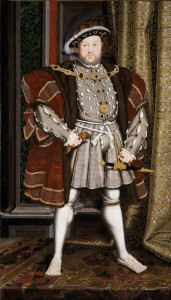This Friday, we’re taking a moment to honor this portrait of Henry VIII from the workshop of Hans Holbein for this week’s #fancyfriday title!

c/o Wikimedia
You’ve probably seen this painting of Henry VIII before. It’s generally the most famous portrait of the infamous monarch, and is usually the one that pops up in history textbooks. That’s because it shows Henry in all his kingly glory—he’s head-to-toe fancy.
Henry VIII was the monarch you probably learned the most about in history classes. He’s known for having six wives (some of whom were executed or died under mysterious circumstances), separating Britain from the sphere of the Catholic Church (so that he could continue to marry whomever he pleased), and creating the Church of England (and setting into motion decades of religious strife to follow). The modern fascination with Henry hasn’t ceased—he’s been the subject of countless biographies and an HBO miniseries, in addition to the many portraits Henry ordered be painted in his own time.
Many of these portraits were created by Hans Holbein the Younger, the painter-in-residence at the English court. Born in Germany, Holbein moved to England to paint for the royal family. He created countless portraits of Henry VIII, his family, and members of his court. This particular painting of Henry VIII is credited differently—it was most likely created by the other painters of Holbein’s workshop, and perhaps was a collaboration. So we just credit it to the Workshop of Hans Holbein the Younger.
As we’ve seen in Hyacinthe Rigaud’s portrait of Louis XIV, artists tend to pull out all the stops for royal portraits. They’re painting for the highest authority in the land, and they don’t want to do anything to upset them—that would lead to the loss of a job, or worse. So Henry, depicted in all his regal splendor, looks about the same size as he did in another portrait done by Holbein when the king was a bit younger. His wealth has only amassed—he’s bedecked with jewels, furs, and elegantly patterned, expensive fabrics, and he’s surrounded by elegant curtains, carpets, and columns. However, his knife is at the ready, possibly to quash any disagreements. Henry’s gaze meets ours straight-on and his legs are placed squarely apart, as if he’s standing his ground. It’s as if he’s daring us to test his authority.
Yet his shoes are more of a slipper than a military boot. I’m unfamiliar with the fashions of the 1540s, but my guess is that if Henry wanted to appear as only a military force, he’d probably have wanted to be painted in boots, or some similar type of footwear. But he went with the slippers, and the result is a bit more casual. Henry looks as if perhaps the painter came too early and he still hasn’t changed into his proper shoes yet—but he doesn’t really care because he’s the king and can do what he wants. Which is definitely in line with his personality.
The Workshop guys (because they were most likely all guys) hit the nail on the head with this one—Henry VIII’s portrait accurately depicts his personality, authority, and sheer fanciness.







